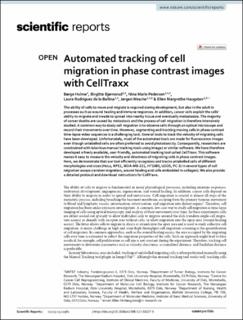| dc.contributor.author | Holme, Børge | |
| dc.contributor.author | Bjørnerud, Birgitte | |
| dc.contributor.author | Pedersen, Nina Marie | |
| dc.contributor.author | Rodriguez de la Ballina, Laura | |
| dc.contributor.author | Wesche, Jørgen | |
| dc.contributor.author | Haugsten, Ellen Margrethe | |
| dc.date.accessioned | 2024-02-26T09:50:23Z | |
| dc.date.available | 2024-02-26T09:50:23Z | |
| dc.date.created | 2024-01-02T11:52:56Z | |
| dc.date.issued | 2023 | |
| dc.identifier.citation | Scientific Reports. 2023, 13 (1), 1-20. | en_US |
| dc.identifier.issn | 2045-2322 | |
| dc.identifier.uri | https://hdl.handle.net/11250/3119846 | |
| dc.description.abstract | The ability of cells to move and migrate is required during development, but also in the adult in processes such as wound healing and immune responses. In addition, cancer cells exploit the cells’ ability to migrate and invade to spread into nearby tissue and eventually metastasize. The majority of cancer deaths are caused by metastasis and the process of cell migration is therefore intensively studied. A common way to study cell migration is to observe cells through an optical microscope and record their movements over time. However, segmenting and tracking moving cells in phase contrast time-lapse video sequences is a challenging task. Several tools to track the velocity of migrating cells have been developed. Unfortunately, most of the automated tools are made for fluorescence images even though unlabelled cells are often preferred to avoid phototoxicity. Consequently, researchers are constrained with laborious manual tracking tools using ImageJ or similar software. We have therefore developed a freely available, user-friendly, automated tracking tool called CellTraxx. This software makes it easy to measure the velocity and directness of migrating cells in phase contrast images. Here, we demonstrate that our tool efficiently recognizes and tracks unlabelled cells of different morphologies and sizes (HeLa, RPE1, MDA-MB-231, HT1080, U2OS, PC-3) in several types of cell migration assays (random migration, wound healing and cells embedded in collagen). We also provide a detailed protocol and download instructions for CellTraxx. | en_US |
| dc.language.iso | eng | en_US |
| dc.publisher | Springer Nature | en_US |
| dc.rights | Navngivelse 4.0 Internasjonal | * |
| dc.rights.uri | http://creativecommons.org/licenses/by/4.0/deed.no | * |
| dc.subject | Particle tracking detectors | en_US |
| dc.subject | Particle tracking detectors | en_US |
| dc.subject | Cell migration | en_US |
| dc.subject | Cell migration | en_US |
| dc.title | Automated tracking of cell migration in phase contrast images with CellTraxx | en_US |
| dc.title.alternative | Automated tracking of cell migration in phase contrast images with CellTraxx | en_US |
| dc.type | Peer reviewed | en_US |
| dc.type | Journal article | en_US |
| dc.description.version | publishedVersion | en_US |
| dc.rights.holder | © The Author(s) 2023. Published by Springer Nature. | en_US |
| dc.source.pagenumber | 20 | en_US |
| dc.source.volume | 13 | en_US |
| dc.source.journal | Scientific Reports | en_US |
| dc.source.issue | 1 | en_US |
| dc.identifier.doi | 10.1038/s41598-023-50227-9 | |
| dc.identifier.cristin | 2218811 | |
| dc.relation.project | Norges forskningsråd: 262652 | en_US |
| cristin.ispublished | true | |
| cristin.fulltext | original | |
| cristin.qualitycode | 1 | |

